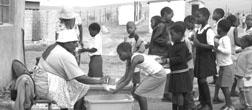 First of all, Benedictine Hospital is one out of four district hospitals in the province. Hospitals are categorized by the number of beds, number of physicians, type of specialties/wards, and facilities. District hospitals are midrange Volvo whereas the two regional hospitals are the fullsize SUVs. Benedictine is not equipped with CT or MRI scanners, but has all the major wards, 300 beds, and a major referral center for clinics and hospitals for miles around.
First of all, Benedictine Hospital is one out of four district hospitals in the province. Hospitals are categorized by the number of beds, number of physicians, type of specialties/wards, and facilities. District hospitals are midrange Volvo whereas the two regional hospitals are the fullsize SUVs. Benedictine is not equipped with CT or MRI scanners, but has all the major wards, 300 beds, and a major referral center for clinics and hospitals for miles around.Before the patient can proceed to the OPD, the sisters and sirs (Enrolled Nursing Assistant) as the gatekeeper evaluate each patient. The sisters/sirs work up the patients by deciding if further evaluation is needed in OPD, sending the patient to a specific department (ARV clinic, Ob/Gyn, etc), or completing the appropriate assessment and plan. This process decreases the number of patients needed to be seen in the OPD and furthers the medical history taking.
After 1-2 hours, the patient enters the OPD on a stretcher, wheelchair, or unassisted. Dr. Hla Tun makes his home in the OPD seeing upwards to 100 patients from 8:30 am to 4:30 pm daily. Due to the huge influx of patients and time constraints, his mantra of “common things common” guides his differential and diagnosis. The patients quietly and patiently shuffle through in an automated assembly line, spending as little as 1 minute and as much as a sporadic 10 minutes per patient – a phenomenon unknown to me back in the states. The patients are gracious, knowing that the doctor must see many patients. They sit; he asks pointed questions; they answer succinctly and quickly; he does a focused physical exam if at all; he orders labs, X-Ray or referrals; and then next. If lab, procedures, or images are ordered, the patient returns to the queue and returns to the OPD with the results. Overall, history taking is minimal; physical exam is expedited; and treatment is immediately dispensed.
Concurrently, a flurry of sisters and sirs comes in with charts and documents to be signed off or he scurries off to the Emergency/Trauma Room next door for a lumbar puncture, intubation, or pleural taps. Sometimes the chaotic OPD room is filled with five people with five different requests for Dr. Hla Tun.
Although the OPD can be uncontrollably frenetic, the tone is unusually relaxed. Tea time and lunch break reduces the eight hour day to only six hours and the clock never runs past 4:30 pm. As a consequence the day runs fast and efficiently.










No comments:
Post a Comment